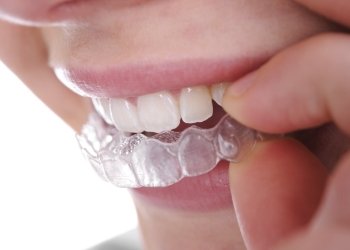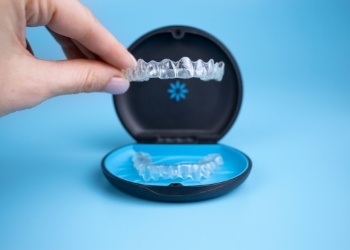Invisalign Clear Aligners in Gorham
You Deserve to Never Hesitate to Smile

Historically, achieving a straighter smile meant enduring the metal brackets of traditional braces. You deserve a modern solution that fits seamlessly into your life—Invisalign. This treatment is reshaping the world of dentistry with a convenient and nearly invisible path to your dream smile.
We picture a world where your confidence isn't held back by lengthy and uncomfortable dental treatments. These clear aligners are custom-designed to gradually adjust your teeth, giving you the stunning smile you've always desired.
Schedule a free consultation with our team at Morgan Dental Care. Together, we'll explore your smile goals and determine how Invisalign can help you reach them!
Why Choose Morgan Dental Care for Invisalign?
- FREE 1st Visits & 2nd Opinions
- Image-Friendly Treatment for Teens & Adults
- Comfortable & Welcoming Office Environment
How Invisalign Works

Invisalign utilizes sets of clear plastic aligners to slowly shift your teeth into a straighter and healthier position. You’ll wear each set of aligners for roughly two weeks at a time, and you’ll gradually advance to new sets of trays to match your teeth’s progress. However, this can only happen if the aligners are worn for 20 – 22 hours every day; in fact, this is considered the “golden rule” of Invisalign! You’ll still have to visit us every six or so weeks for checkups and to pick up your new sets of aligners, but you don’t have to visit nearly as often as you would with traditional braces.
Who Can Invisalign Help?

With more than 17 million patients around the world, it’s safe to say that Invisalign is quite versatile! In fact, it can improve your self-esteem while also mitigating potential oral health issues, like tooth decay. To learn more, you can read on. You can also schedule a consultation so we can determine if clear aligner treatment is right for you!
Crowded Teeth
Unfortunately, having crooked and crowded teeth can take a toll on your self-esteem as well as expedite issues like tooth decay. Don’t worry – there’s good news too: Invisalign can correct mild to moderate cases! This is accomplished with a series of clear aligners, which apply a gentle amount of pressure to different parts of your smile, slowly but surely bringing your teeth into their properly aligned positions.
Gaps Between Teeth
Gaps between teeth aren’t just embarrassing; they can also trap food debris and bacteria that lead to unpleasant oral health issues, like periodontal disease. To prevent that from happening, we recommend exploring your orthodontic treatment options early on. If you’re a candidate for Invisalign, then we can eliminate those spaces with clear aligners so that your teeth stay healthy and look uniform.
Overbite
Overbites are a common orthodontic problem that, unfortunately, can have devastating consequences on both the health and function of your smile. For that reason, we recommend exploring your treatment options sooner rather than later. If Invisalign is a solution for you, then your journey to a healthier, happier smile will be virtually undetectable and considerably more comfortable than traditional braces.
Underbite
A misaligned bite can place gratuitous pressure on your jaw, causing issues like chronic pain, TMJ disorder, and bruxism (teeth grinding and clenching). Previously, there was one way to fix common bite problems, like underbites: traditional braces. Now, Invisalign can be used to bring your teeth and bite into proper alignment, improving your confidence, oral health, and overall quality of life in the process.
Crossbite
Crossbites, like the other bite problems on this list, can negatively impact your smile in more ways than one. So, if you are struggling with this common orthodontic issue, don’t wait – schedule a consultation with us so we can determine if you’re a candidate for Invisalign. If the answer is “yes,” then we will align your bite without the metal, ensuring no unwanted attention is drawn to your smile along the way.
Open Bite
Sometimes, patients are unable to bite down evenly because there is space toward the front or back of their mouth. If that’s the case for you, then schedule a consultation with us; it’s time to find out if you’re a candidate for Invisalign! That way, we can bring your bite into alignment before you experience chronic issues, like jaw pain and premature wear and tear on certain teeth.
Benefits of Invisalign

If you’re still on the fence about committing to this unique orthodontic treatment, then you might find it helpful to hear why more than 17 million patients have chosen Invisalign! Below, you will find several noteworthy reasons this smile-enhancing solution has remained popular for 20+ years.
Improved Comfort
Unlike traditional braces, which have metal brackets and wires, Invisalign aligners are crafted with your comfort in mind. Not only are they made from a smooth, durable plastic, but they fit the contours of your teeth perfectly, making them far less likely to irritate your gums. Plus, there aren’t monthly adjustment appointments. Instead, your teeth are gently and gradually moved into their ideal positions.
Faster Average Treatment Timeline
Oftentimes, traditional braces take anywhere from 2 to 3 years to deliver results. Invisalign, on the other hand, can often be completed in just 12 to 18 months. It’s possible for your treatment timeline to be even shorter if your case of misalignment is mild and you follow all of the guidelines we provide – from wearing the aligners for 20+ hours a day to switching to each new set on the correct day.
Basically Invisible Braces
Invisalign aligners are virtually undetectable while they’re being worn. As a result, no one will be able to tell that you’re undergoing orthodontic treatment unless you tell them! The key to keeping your braces basically invisible is taking good care of your aligners. Don’t worry – you don’t need any expensive cleaning products to prevent stubborn stains from surfacing. Simply use a soft-bristled toothbrush and clear, mild dishwashing liquid to clean them every morning and night.
Hassle-Free Dental Care
Since traditional braces are bonded in place, patients need to brush and floss around the brackets and wires. Invisalign aligners, on the other hand, are removable. So, you won’t need to buy any special dental care products or adopt a cumbersome oral hygiene routine! Just continue to brush twice a day, floss every night, and rinse with an ADA-approved mouthwash consistently.
Freedom to Eat Your Favorite Foods
Another considerable perk: you don’t have to completely alter your diet with Invisalign. All we ask is that you are mindful of your intake of sugary and starchy snacks since they increase your risk of dental decay. If you have a lot of attachments, it’s also a good idea to exercise caution with crunchy foods, like tortilla chips, cashews, popcorn, and carrots.
Fewer Appointments
Adjustment appointments are usually every month with traditional braces. The teeth-straightening process looks a bit different with Invisalign. Instead, the patient is given several sets of aligners so they can progress through portions of their treatment plan at home. Then, every 6-8 weeks, they attend a progress visit. At these appointments, we monitor the movement of your teeth to make sure they are tracking as anticipated.
Living with Invisalign Aligners

Invisalign clear aligners can be an easier and more convenient way to straighten your teeth than traditional metal braces, but they still require a big commitment of effort and discipline. However, the treatment only requires minimal alterations of the patient’s daily routine, and it can deliver amazing results in briefer timeframes than other orthodontic methods. Here’s a brief overview of a few aspects of living with Invisalign aligners from the team at Morgan Dental Care, but please contact our staff in Gorham if you have any questions.
Wearing Your Trays
You’ll need to wear your appliances for at least twenty hours each day to keep your treatment on track and switch to the next set of aligners in your sequence every two weeks or so depending on the details of your treatment plan. Neglecting to wear your trays sufficiently will lead to potentially costly treatment delays, so it’s best to wear your aligners at all times when not eating, performing oral hygiene, or drinking anything but water.
Cleaning Your Aligners
Hot or cold liquids can cause your aligners to warp, so be sure to only clean them with cool or lukewarm water. It’s also important to thoroughly rinse your aligners off to eliminate loose food debris each time before placing them in your mouth. You’ll also need to properly clean your aligners once a day by soaking them with Invisalign crystals or gently treating them with a soft-bristled toothbrush and clear hand soap. Excellent oral hygiene is also crucial, so you’ll always need to thoroughly brush and floss before reinserting your clear aligners.
Eating & Drinking
While Invisalign allows you to eat and drink whatever you like, it’s crucial to only do so when your aligners are outside of your mouth. Eating or drinking anything but liquid water while wearing your trays can break or warp your devices or lead to infection-causing food residue becoming trapped beneath them, and it can also lead to conspicuous stains forming on your aligners. When you remove your clear aligners, store them in a clean protective case to prevent them from being damaged or accidentally disposed of.
Losing or Damaging a Tray
Contact our office if your Invisalign tray is damaged or lost so we can recommend an appropriate solution. If you have been wearing the tray for a while, we may tell you to simply switch to the next tray in your sequence. However, it may be necessary for you to switch back to the previous tray while we manufacture new appliances for you.
Routine Check-Ins
Invisalign checkups are usually scheduled every four to eight weeks, and they allow us to monitor your treatment and provide you with new aligners when necessary. These visits usually take only fifteen minutes or so, and the brevity and infrequency of these appointments can make Invisalign especially excellent for patients with busy schedules.
Understanding the Cost of Invisalign

Every smile is unique, and so is the cost of each Invisalign treatment. Because each set of clear aligners is designed with a patient’s specific needs in mind, we can’t give you an accurate cost estimate until we’ve had the chance to examine your smile. Rest assured that before moving forward with the process, we’ll thoroughly explain your financial options, such as dental insurance and CareCredit. We’re even offering a limited-time special for a FREE Invisalign consultation!
Factors That Affect the Cost of Invisalign
Like many dental treatments, multiple factors must be considered when determining how much Invisalign costs. When you visit us for an Invisalign consultation, our dentists will come up with a cost estimate based on the answers to several questions, such as:
- Will you need to wear aligners on your upper teeth, your lower teeth, or both? Naturally, the fewer aligners you need to wear, the less your treatment will cost.
- How misaligned are your teeth? Fixing slightly gapped teeth will be easier and less expensive than aligning a severe overbite and multiple crooked teeth.
- How long will your treatment take? If our dentists discover that you need more aligners than originally planned, your overall costs will increase.
Invisalign vs. “Do-It-Yourself” Clear Aligners: Price vs. Value
As Invisalign has risen in popularity, so have “do-it-yourself” clear aligner kits. It may be tempting to save money with these cheaper alternatives, but Invisalign is an investment worth making for several reasons:
- When you’re responsible for creating your aligners, there’s the risk of making a mistake and causing your teeth to move in different directions than intended. You might end up worsening your orthodontic problems and having to pay even more money to get them corrected by a professional instead.
- You won’t have a dentist overseeing your progress every few weeks. If something goes wrong with your treatment, you might not notice until serious damage has been done.
- If you have a question or concern, you’ll have to deal with a customer service rep who may not be qualified to help you. With Invisalign, all you have to do is call us, and we can provide you with the guidance you need.
Does Dental Insurance Cover Invisalign?
Your dental insurance provider might cover Invisalign to some degree, but it depends on the details of your specific plan. For example, some plans cover orthodontic work at 50% but only for patients under the age of 18. Others might only pay for traditional braces, not Invisalign. Our team will gladly help review your policy and handle the claims filing process for you to ensure you’re getting the most out of your benefits.
Options for Making Invisalign Affordable
At Morgan Dental Care, we offer other ways of helping patients afford Invisalign besides just insurance. Some of our financial options, which you can find on our New Patients page, include:
- Traditional payment methods – We give a 5% courtesy when patients use cash, check, or debit card, and a 3% courtesy when patients use a credit card.
- CareCredit – You can split up your treatment costs into monthly chunks with one of these low- to no-interest payment plans.
Invisalign FAQs
Before you commit to Invisalign to straighten your smile, you want to be well-informed about the treatment and what you can expect. Here are the answers to some of the most common questions that we receive about Invisalign. If you don’t see your question listed below, don’t worry. Our team would be happy to get you the information you’re looking for and set you up with a consultation where you can learn more. Just give us a call!
Does Invisalign Hurt?
No teeth straightening option leaves patients completely free of discomfort, but Invisalign is not painful. Its smooth, plastic design makes it one of the most comfortable orthodontic treatments out there. When you first get Invisalign, there’s an adjustment period where you may experience slight soreness or discomfort, but this will go away as you become accustomed to the treatment. Invisalign works by gradually shifting your teeth with a series of aligners, so whenever you switch to a new set of aligners, you may experience some pressure, but this just indicates that the treatment is working! To reduce any soreness, over-the-counter medication or a cold compress can be used.
Can You Eat with Invisalign?
One of the greatest advantages of Invisalign is that you don’t need to cut any of your favorite foods out of your diet. Since your aligners are removable, this makes it possible to eat and clean your teeth with ease. Just keep in mind that you need to remove your aligners before eating. Eating while wearing your Invisalign can damage your aligners and put unnecessary pressure on your teeth. Because of this, the only thing you should be consuming while wearing them is water.
Can You Get Invisalign After Braces?
In many cases, yes! Having braces in the past doesn’t affect your ability to get Invisalign. It all depends on the severity of your misalignment issues and whether or not Invisalign will be able to properly correct them. Braces are better able to correct more severe overbites, underbites, and crossbites than Invisalign. This is why many patients may choose traditional braces instead. However, if your teeth have become crooked or misaligned years after you completed treatment with braces, Invisalign can usually help. During your initial consultation, it will be determined whether or not Invisalign is the best option for you.
Who Is a Candidate for Invisalign?
There are several factors to consider when determining whether or not Invisalign is a good option. Age is the most significant one because the jaw and teeth are still constantly changing and growing from childhood to teen years. Invisalign can be used for any patient who has full, permanent teeth, so teens can undergo this treatment as young as 13 years old. It is also important that all patients wear their aligners at least 20 hours a day, so responsibility is a factor as well. Invisalign can correct crooked, gapped, and misaligned teeth, but some bite problems may be too severe and require traditional orthodontic treatment.
